

Douglas Aircraft knew it had a winner with the DC-4, since it was obvious that with hundreds of military examples it would become the standard post-war long distance airliner. However, the presence of the Lockheed L-049, which was generating significant orders, led Douglas to decide to develop a stretched and improved version of the DC-4. Since the two major advantages of the L-049 were speed and pressurization, the new DC-6 would be powered by new and powerful Pratt & Whitney R-2800 engines, stretched by almost 7 feet over the DC-4, and would be pressurized to allow the plane to fly at fuel-economical high altitude, which also avoided the worst weather. Since this decision was made during WWII, it's not surprising that the actual DC-6 prototype was built to a USAAF requirement, the XC-112. The first flight didn't occur until February 15, 1946, however, and with the end of the war the military had little use for the plane. Douglas quickly converted it into a commercial project, which became the DC-6.
The airlines had seen the potential of the XC-112 long before the war ended, and orders were placed as early as September 1944 for post-war deliveries. American Airlines received the first plane (from its 50 plane order) in November 1946, with United Air Lines following with a 20 plane order. However, United had the honor of introducing the DC-6 into scheduled service, on the one-stop US transcontinental route, making the flight in only 10 hours. This compares quite favorably with the 11 hours taken by the L-049 Connie and 14 hours by the DC-4. The DC-6 did have one black mark on its record; the plane was grounded for 4 months from November 12, 1947 following two internal fuselage fires. The last DC-6 was delivered to Braniff on November 2, 1951, the production line being used instead for the stretched DC-6B, with better economics (although slightly reduced performance). A total of 175 DC-6's were produced, and proved to be very reliable performers. Because of this reliability and ruggedness, a few DC-6's are still flying today, mostly in cargo work.
High quality R-2800 DC-6 stereo sounds are available from Jon Jefferys. These are the best I've heard so far. They are designed to be used with the FS2004 slow engine startup. This package is downloaded separately; the base packs include a much smaller PropSound package. Now version 2!
To repaint the GMAX DC-6's you can use the Paint kit for DC-6's. Contains layered PSD files (usable in both Photoshop and Paint Shop Pro) which allow you to place your paint scheme between the bare metal layers and the windows and doors. Makes for fast painting! Note: there are no detailed instructions in the file; follow the instructions in my Repainting Tutorial for PSP or another tutorial. Last updated on 10/28/10. (19 MB).
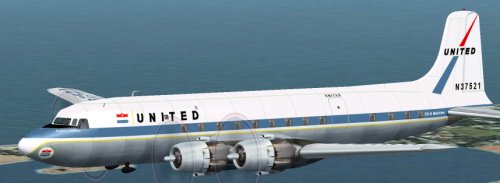 FS2004
United Air Lines DC-6 1958 Base Pack. FS2004 ONLY. Greg
Pepper created the GMAX DC-6B, and I've shortened it to create the DC-6!
I've painted it up into the later colors they wore at United, the "jet delivery"
colors (although propliners were painted in this scheme before the DC-8's arrived).
Appropriate to this site, this is the Mainliner California. Now includes non-radar
nose versions. Requires the FS2004 United DC-6B
for panel and sounds. Last modified on 8/4/19.
FS2004
United Air Lines DC-6 1958 Base Pack. FS2004 ONLY. Greg
Pepper created the GMAX DC-6B, and I've shortened it to create the DC-6!
I've painted it up into the later colors they wore at United, the "jet delivery"
colors (although propliners were painted in this scheme before the DC-8's arrived).
Appropriate to this site, this is the Mainliner California. Now includes non-radar
nose versions. Requires the FS2004 United DC-6B
for panel and sounds. Last modified on 8/4/19.
FSX/P3D DC-6 Base Pack. I've converted the models to FSX native format for use in FSX and P3D. This is a full package and does not need the FS2004 Base Pack above. Requires theFSX/P3D United DC-6B for panel and sounds.Last updated on 10/25/20.
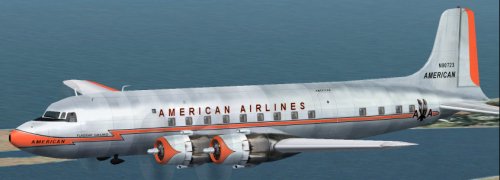 FS2004/FSX American Airlines DC-6 1963. Textures
Only. I've painted our DC-6 into American colors too.
Here is Flagship Oakland in the later American radar equipped colors.
American owned 50 DC-6's, and used them throughout their domestic system. Requires
the UAL DC-6 above and the United
DC-6B for panel and sounds. Last modified on 9/30/09.
FS2004/FSX American Airlines DC-6 1963. Textures
Only. I've painted our DC-6 into American colors too.
Here is Flagship Oakland in the later American radar equipped colors.
American owned 50 DC-6's, and used them throughout their domestic system. Requires
the UAL DC-6 above and the United
DC-6B for panel and sounds. Last modified on 9/30/09.
 FS2004 American Airlines DC-6 1951. Jens Kristensen has taken his
great DC-4 and turned it into a DC-6! It has the early CA-15 engines and round
tipped props, unlike Greg and my later DC-6 with CB-16 engines and square tipped
props. He has painted it into the first airline to take delivery, American.
American owned 50 DC-6's, and used them throughout their domestic system.
Also includes United and Delta liveries. Comes complete with
panel. Thanks Jens! Last updated on 1/5/09. Manual supercharger switching instructions. FSX
Version. Last updated on 1/5/09.
FS2004 American Airlines DC-6 1951. Jens Kristensen has taken his
great DC-4 and turned it into a DC-6! It has the early CA-15 engines and round
tipped props, unlike Greg and my later DC-6 with CB-16 engines and square tipped
props. He has painted it into the first airline to take delivery, American.
American owned 50 DC-6's, and used them throughout their domestic system.
Also includes United and Delta liveries. Comes complete with
panel. Thanks Jens! Last updated on 1/5/09. Manual supercharger switching instructions. FSX
Version. Last updated on 1/5/09.
FSX/P3D MDL Files. Last updated on 11/2/2020.
 FS2004
United Air Lines DC-6. Jens Kristensen has painted up his early GMAX
DC-6 into the delivery colors for the initial customer, United. UAL first
called them "Mainliner 300", since they cruised at 300 mph. Also includes American and Delta liveries. Manual supercharger switching instructions. FSX
version. Thanks, Jens! Last updated on 1/5/09.
FS2004
United Air Lines DC-6. Jens Kristensen has painted up his early GMAX
DC-6 into the delivery colors for the initial customer, United. UAL first
called them "Mainliner 300", since they cruised at 300 mph. Also includes American and Delta liveries. Manual supercharger switching instructions. FSX
version. Thanks, Jens! Last updated on 1/5/09.
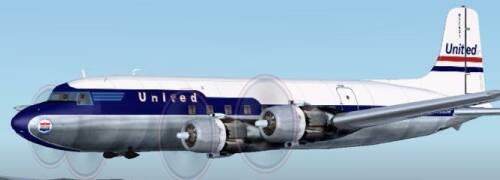 FS2004/FSX
United Air Lines DC-6. Here is Greg's DC-6 that Wayne Tudor has painted
into the later "white top" version of the classic United Scheme. Thanks!
Requires the UAL DC-6 above and the United
DC-6B for panel and sounds. Last updated on 1/12/05.
FS2004/FSX
United Air Lines DC-6. Here is Greg's DC-6 that Wayne Tudor has painted
into the later "white top" version of the classic United Scheme. Thanks!
Requires the UAL DC-6 above and the United
DC-6B for panel and sounds. Last updated on 1/12/05.
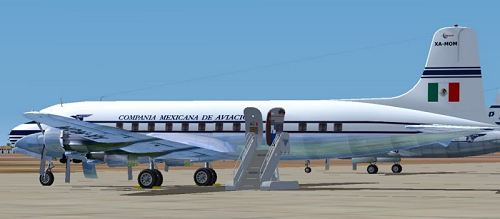 FS2004/FSX Mexicana DC-6.
The airline Compania Mexicana de Aviacion, later known just as
Mexicana, flew to Los Angeles from Mexico City and other Mexican
cities. While originally owned by Pan American (thus the winged
globe logo), it became fully independent by the late 1960s. Dave
McQueen has painted up this fine rendition of their DC-6 in the
original colors of the 1950s. Thanks! 1962 and 1968 versions by Juan Antonio Martinez Castro. Requires the UAL DC-6 above and the United
DC-6B for panel and sounds. Last updated on
6/8/16.
FS2004/FSX Mexicana DC-6.
The airline Compania Mexicana de Aviacion, later known just as
Mexicana, flew to Los Angeles from Mexico City and other Mexican
cities. While originally owned by Pan American (thus the winged
globe logo), it became fully independent by the late 1960s. Dave
McQueen has painted up this fine rendition of their DC-6 in the
original colors of the 1950s. Thanks! 1962 and 1968 versions by Juan Antonio Martinez Castro. Requires the UAL DC-6 above and the United
DC-6B for panel and sounds. Last updated on
6/8/16.
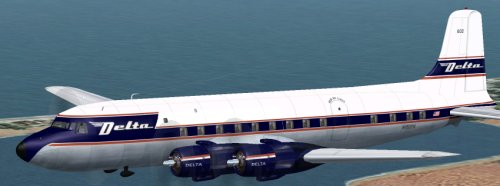 FS2004/FSX Delta Air Lines DC-6. Jim Campisi and Tim
Withers have painted Greg's new DC-6 into the conservative colors of Delta,
which used them throughout the South. They were one of the few US
airlines that owned the DC-6 but not the DC-6B - Delta stepped up to the DC-7
and never looked back. Before the '7 arrived, though, the trusty DC-6 was used
in interchange service to California too. Thanks Jim and Greg! Use
only the textures from this package. Requires the UAL
DC-6 above and the United DC-6B for panel and sounds.
Last modified on 6/30/03.
FS2004/FSX Delta Air Lines DC-6. Jim Campisi and Tim
Withers have painted Greg's new DC-6 into the conservative colors of Delta,
which used them throughout the South. They were one of the few US
airlines that owned the DC-6 but not the DC-6B - Delta stepped up to the DC-7
and never looked back. Before the '7 arrived, though, the trusty DC-6 was used
in interchange service to California too. Thanks Jim and Greg! Use
only the textures from this package. Requires the UAL
DC-6 above and the United DC-6B for panel and sounds.
Last modified on 6/30/03.
 FS2004/FSX British
Commonwealth Pacific Airlines DC-6. Wayne Tudor has painted up the
DC-6 into the colors of BCPA, the first Australian airline to fly to the US.
This route was later taken over by QANTAS. Thanks! Requires the UAL
DC-6 above and the United DC-6B for panel and sounds.
Last updated on 4/22/09.
FS2004/FSX British
Commonwealth Pacific Airlines DC-6. Wayne Tudor has painted up the
DC-6 into the colors of BCPA, the first Australian airline to fly to the US.
This route was later taken over by QANTAS. Thanks! Requires the UAL
DC-6 above and the United DC-6B for panel and sounds.
Last updated on 4/22/09.